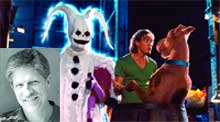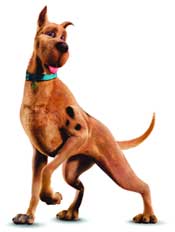
Bill Kroyer (inset) and the Rhythm & Hues team were challenged with bringing the 2D Scooby's "good stuff" into the world of 3D.
|
LOS ANGELES - He's a dog... but he's not. He's a cartoon... but he's not. The lovable and easily spooked 2D cartoon character that was created by Hanna-Barbera the '70s TV show by Hanna-Barbera is currently starring in a big-budget feature film. And the LA-based visual effects house that created him may have just raised the bar for 3D animated characters who can elicit the same kind of emotions from viewers as carbon-based actors.
"When I first heard they were making a film out of Scooby-Doo, my first reaction was - it's a challenge because you're taking a well-known character, who's always existed as a 2D cartoon, and you are bringing him into the 3D world," says Bill Kroyer, senior animation supervisor at Rhythm & Hues and co-animation supervisor of Scooby-Doo, "There are things that work in two dimensions that don't work in three dimensions, but there are new opportunities in 3D that you never had in 2D. So how do we take the good stuff from the 2D cartoon Scooby and bring him to life in the 3D world? That was the challenge of the design team."
"The difference between 2D and 3D," says Scooby co-animation supervisor Leon Joosen, "is that you have to be very, very conscious of the actual weight and bearing of a 3D character, like Scooby, as compared to the live actors that surround him. So in a 2D version he could be more animated, he could be more against the laws of physical nature, and it doesn't really matter because everything else within that environment acts the same way. But immediately, when you place him from the 2D into a 3D realm, suddenly he has to have dimension, he has to have weight, he has to have volume, and he also has to react with live actors who absolutely deal with the laws of physical nature."
LIVING IN A LIVE-ACTION WORLD
The number one thing that Warner Bros. wanted, states Kroyer emphatically, was that the CG Scooby really looked like it belonged in the live-action world. "So right away we ended up with the idea that this Scooby is going to be photo-real. But nobody thought that Scooby-Doo should look like a real dog, because he's Scooby-Doo; he has his own personality, he has his own style."

Rhythm & Hues called on the talents of 38 animators and its own proprietary software to create the lovable Scooby-Doo.
|
Kroyer had this fun idea: he did a completely photorealistic painting of the cartoon Scooby, took a photo of a real dog, and did a morph sequence between the two. "So we had every single stage, every percentage, 10 percent, 20 percent, 30 percent from a total cartoon Scooby to a real Scooby, and somewere in the middle we found the Scooby that we liked."
One of the first things they did, describes Joosen, was to study the motion of both adult Great Danes and also puppies. "The adult Great Dane has the weight, balance and force that Scooby would need, but a puppy has that rambunctiousness, that spontaneity, that the full grown Great Dane wouldn't have."
When you see Scooby-Doo on the screen in this movie I think you'll be mesmerized, says Kroyer, "because you completely believe he's a real thing, but nothing about him looks like a real dog. Subconsciously you'll watch Scooby with the same kind of fascination that you'd watch a cartoon character. You'll go, 'Wow, that motion, I've never seen anything like that, but I believe that there's a 140-pound thing moving through that scene.' It's artful motion. It's an artist's interpretation of how something moves that uses believability, but is not connected to reality. That's what makes it fun."
NO MOTION CAPTURE
It took a team of 38 animators to bring Scooby-Doo and Scrappy-Doo to life. "For Scooby there was no motion capture; it was all animators doing it the traditional way," says Joosen. Rhythm & Hues uses entirely proprietary software so they were able to build, on demand, whatever tools they needed to do the job. Some of the breakthroughs they came up with were interactive fur so that when Scooby moves around his fur moves in a logical way. Another new feature was muscles, continues Joosen. A real Great Dane has muscles, so when Scooby is performing, there appears to be a muscle structure underneath him that seems solid - so he doesn't look like a balloon filled with air. R&H programmers also gave Scooby's animators state-of-the art rigs and tools that automated the interaction between skeleton structures and muscles to make animating easier and more efficient.
One of the things that would be nice to have for the Scooby sequel, says an optimistic Joosen, is some very distinctive muscle actions, like the giggly, shivering flesh on the Jurassic Park dinosaurs. "We know what Scooby's parameters are and it will be nice to begin the next film that way."